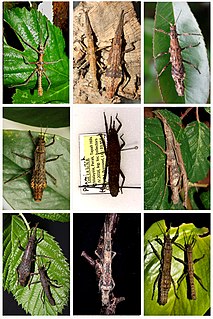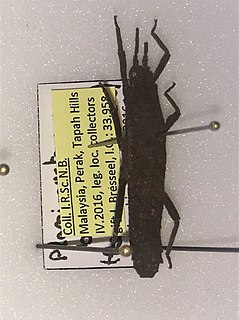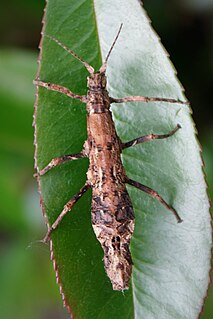
The Heteropterygidae is a family of stick insects belonging to the suborder Euphasmatodea. Species can be found in Australasia, East and Southeast Asia. More than 130 valid species are descriebed.

Pylaemenes is a genus of stick insects in the family Heteropterygidae and subfamily Dataminae. It combines small to medium-sized, often brightly colored Phasmatodea species. Their representatives are found in large parts of Southeast Asia.

The genus Orestes combines relatively small and elongated Phasmatodea species from Southeast and East Asia.

Orestes draegeri is a species of stick insects in the subfamily Dataminae.

The Obriminae are the most species-rich subfamily of the Phasmatodea family Heteropterygidae native to Southeast Asia. It is divided into two tribe.

Datamini is the only tribe within the subfamily of the Dataminae from the order of the Phasmatodea. The representatives of this subfamily are on average not as large as those of the other two subfamilies belonging to the family of Heteropterygidae.

The genus Dares, which is mainly native to Borneo, combines relatively small and mostly dark-colored Phasmatodea species.

The genus Microrestes combines relatively small and squat Phasmatodea species from continental Southeast Asia and South China.

The genus Planispectrum combines very small and compact species from Southeast Asia.

The Obrimini are the most species-rich tribe of the Phasmatodea family of the Heteropterygidae native to Southeast Asia.

Orestes dittmari is a species of stick insects in the subfamily Dataminae.

Trachyaretaon is a genus of stick insects native to the Philippines.

Brasidas is a genus that is native to the Philippines and is named after the Spartan general Brasidas

Orestes mouhotii is an insect species belonging to the order of Phasmatodea. Because of its synyonym Orestes verruculatus, it is the type species of the genus Orestes. Because of its compact body shape, the species is sometimes referred to as small cigar stick insect.

Orestes guangxiensis is a representative of the genus Orestes.

Orestes japonicus, a stick insect, is a representative of the genus Orestes.

Orestes krijnsi is a species of stick insects native to Vietnam.

Orestes subcylindricus is a species of stick insects native to Vietnam.

Pylaemenes elenamikhailorum is a species of stick insects native in Sepilok on Borneo. In application of the more recent differentiation between the genera Pylaemenes and Orestes the species is sometimes also called Orestes elenamikhailorum.
Pylaemenes konkakinhensis is a species of stick insects native in Vietnam. The species is so far only known from a single female.


















